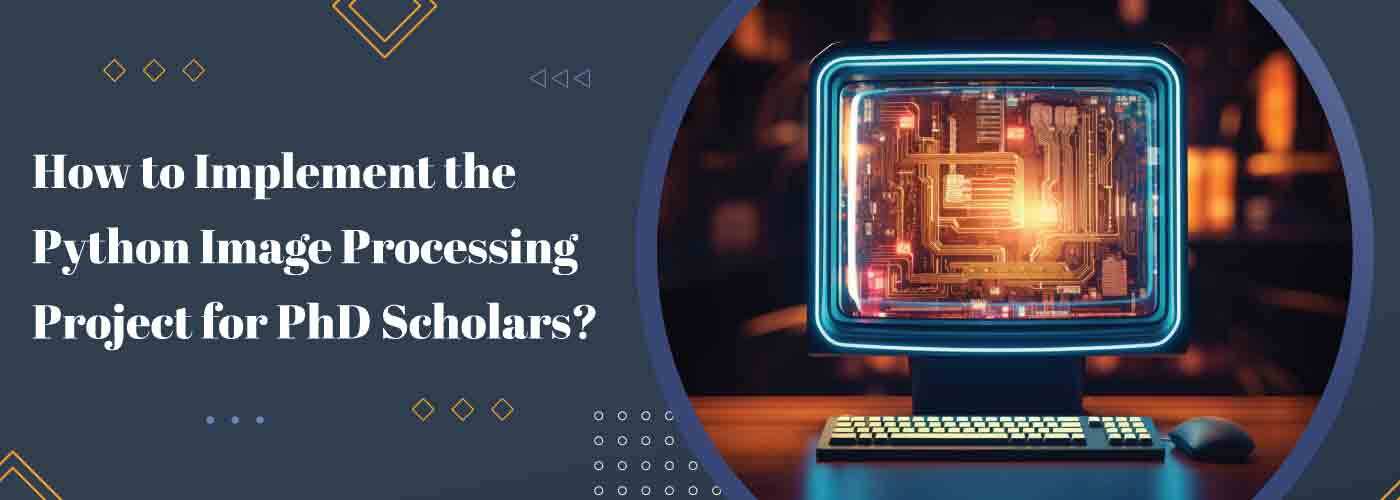How to Implement the Python Image Processing Project for PhD Scholars?
April 18, 2024

Introduction
Python is the leading pioneer of programming language as it can work on various computing platforms. To create web applications and workflows with the software, Python programming language is used. In fields of computer science, engineering, and medical imaging, Python Image Processing plays a vital role, especially for PhD research scholars.
Importance of Image Processing Projects in PhD Research
A signal process that transforms the input image into a digital image and enhances the quality of images which aids researchers in extracting useful information from it is referred to as Image Processing. For PhD Researchers to extract accurate information, demands high-quality images. To improve the quality of the image, it undergoes image processing. Obtained High-quality images allow the researcher to analyze the dataset effectively and create an ingenious solution for the problem in research.
Role of python in Image processing:
The efficiency of Python in image processing is higher, but the syntax of the language is quite similar to the English language which is an exclusive choice for the researchers to choose it. Because of open library sources, faster prototypes, simplicity, and adaptability than other languages makes Python as the leading programming language.

Sources for Image processing in Python:
Various open sources of libraries were accessed for image processing including OpenCV, Pillow, sci-kit-image, Tensor Flow, etc. These sources provide a wide range of functions and algorithms for the task of image manipulation, feature extraction, and machine learning.
Steps to Implement a Python Image Processing Project:
Before entering into the implementation process, it is important to explain current objectives, scope, and timeline of the project. It includes selecting the target audience, choosing accurate datasets, and setting goals
- Retrieving the image from the hardware-based source occurs at image acquisition or pre-processing of image processing.
- For clarity of the image, certain features are enhanced in the Image Enhancement process and it is stored in the restoration process.
- The restored image enters into the phase of color image processing including the color modelling techniques.
- Images are represented by wavelets in different degrees in the process of wavelet and multiresolution processing.
- The resulting images for compression to minimize the size and they are morphologically processed and segmented to make them analyze easily.
Choosing an appropriate algorithm
Implementation in Python:
After completing the Image pre-processing, the pre-processed image is implanted on the appropriate algorithm which is selected based on the requirement of the research. After choosing the better algorithm, the pre-processed image undergoes the process of segmentation, classification, and feature extraction. The technique that segments the pre-processed image into tiny pixels based on the similarities is carried out in the segmentation process. The segmented image will undergo classification and feature extraction to classify and extract the features of the image. The coding of Python applied to the selected algorithm is written to perform analysis which extracts the accurate and appropriate information of the input data.
IDEs for Python
An integrated development environment (IDE) is a combination of various tools which is customized particularly for software editing, building, and testing. It includes the process of debugging, testing, syntax highlighting of the program. For Python, it includes various IDE as PyCharm, Jupyter Notebook, and Visual Studio Code.
Online courses and tutorials
For scholars looking to enhance their Python skills for image processing, numerous online courses and tutorials are available. Platforms like Coursera, Udemy, and YouTube offer courses ranging from beginner to advanced levels, covering topics like computer vision, deep learning, and image analysis.
Case Studies
Example projects
- Using computer vision for Autonomous vehicle navigation.
- Disease diagnosis for segmentation of medical image.
- For environmental monitoring, and image analysis of satellites.
Success stories
To address various struggles and make record-breaking discoveries in their respective fields, Python image-processing projects have been implemented by researchers throughout the world.
Challenges and Solutions
Common Challenges in implementation
- It uses too much memory compared to other languages.
- The presence of limited resources leads to Insufficient data.
- The running time of Python is quite slow.
Strategies to overcome challenges
- By Usage of cloud computing services.
- Use libraries in the region of insufficient data.
- By using appropriate data and algorithms.
Conclusion
PhD researchers should require their skills in coding and deep understanding which are considered as the domain to implement the Python programming in image processing. With the researcher's skills in Python programming language and the availability of resources, the research journey of scholars can be carried out smoothly to the extent.
Implementation is now become the crucial part of PhD paper writings in all fields like electrical, electronics and computer science etc. To know more about implementation process
